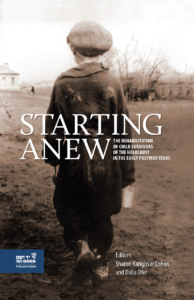I am happy to announce that a new book about child survivors of the Holocaust, in which I have wrote a chapter based on a research study I conducted in 2017, has been published. The book is entitled “Starting Anew: The Rehabilitation of Child Survivors of the Holocaust in the Early Postwar Years”. I was asked by Yad Vashem, the Holocaust Museum and Research Center in my hometown of Jerusalem, to examine a question about which we have little empirical data: did child and adolescent survivors of the Holocaust talk about their ordeals after the end of the war? Did they speak to anyone about what they had gone through?

It was a little late by 2017 to raise this question, as so many child and adolescent survivors were no longer with us, or no longer able to participate in such a study. It was no longer possible to obtain what would be considered a large sample that would be adequately representative of this group of survivors. However, it was still an important and an urgent question to put to those child and adolescent survivors who are still with us. Given the fact that the study took place in 2017, it would be reasonable to assume that the survivors with whom I had the honor to speak were among the most resilient ones, those whose physical and mental health were still good enough. Many of whom were still active as educators and docents in the Museum of Jewish Heritage, a Living Memorial to the Holocaust. The in-depth interviews were poignant, full of insights and wisdom, as the survivors shared with me the memories of what it was like to integrate the life they had before the War, the incomprehensible experiences they lived through at such young ages, how they re-entered life as adolescents in post-war America, how they negotiated the attitudes with which they were met, and moved forward to make their lives.
Almost all the participants stated they did not speak of their Holocaust experiences in the early years and for many years later. There were several distinct reasons given for not having communicated about the War experiences with parents or siblings, nor with other survivors, and why it was impossible to share any of their traumatic memories with non-Holocaust survivors, Jewish or not, in the social environment around the young survivors. One survivor shared how her uncle, who picked her up from the ship that brought her to America, told her on the way to the home of her aunt, his wife, the sister of the survivor: “don’t ever tell her what you saw and what you know”. Others told of teachers and others who specifically instructed them to not speak of their experiences. Hearing about such atrocities was too traumatic for the listeners, and so the child survivors were silent and, unlike the adult survivors of the Holocaust, who spoke among themselves, the young survivors hid their past, remained silent, and focused on assimilating and becoming indistinguishable from their peers.
The results from this study reflect the memories of post-war adaptation in a unique sample of highly functional and resilient child and adolescent survivors, corroborating the notion of a “conspiracy of silence” in the early years. The in-depth interviews offer important insights about the adaptation of young refugees to the new environment. The alienating and painful attitudes of the social environment around the young survivors were still vividly and poignantly recollected. However, this group of survivors coped by intensely focusing their energy and efforts on learning the new language, making up for lost years of schooling, and acquiring the ways of doing things that allowed them to assimilate and “to feel normal” as fast as they could. The recollections of these child and adolescent survivors of the Holocaust still hold the painful wounds inflicted after the end of the war by the lack of social support from the wider society, and due to the absence of mental health services in the early postwar years. The resilient and successful lives these young survivors went on to live highlights the critical importance of providing young refugees survivors of trauma with immediate opportunities for learning the necessary skills to become successful in the new environment. The immediacy of such opportunities might make all the difference between re-traumatization and defeat, and successful rehabilitation and re-integration of young trauma survivors.
Thank you to all the amazing survivors who agreed to share with me their precious life stories.
If you would like to read more, the book should be available soon from the online bookstore of Yad Vashem.
Irit Felsen

!מזל טוב